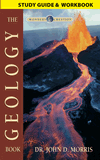Having It Both Ways?
If the present isn’t the key to the past, a critic wants to know why AiG uses present events to explore what happened in the global Flood. Dr. Andrew Snelling, AiG–U.S., explains.
In the recent article “How Old Does the Earth Look?” by Andrew Snelling, you continue to want things both ways. The intent of the article was to deride the well-supported notion that processes in the present are key to those in the past. And then you cite the tired example of the erosion in the aftermath of the Mt. St. Helens eruption as evidence of what you claim occurred in the past. Your archives (yes, I have read them) are full of such instances (I could cite ten of them without even looking them up) in which you use present-day observations to argue for what you contend must have happened in the past. It is sad than even the scientists among you have such a myopic view of the way in which science actually works. It is probably a symptom of talking only to each other because you are not taken seriously by working scientists.
—R.M., PhD
Food for Thought
I just wanted to thank . . . Ken Ham and this organization for the answers it gives. You are truly helping us give a good defense for what we believe. Yesterday, I was confronted by a fellow student who claimed to be a Christian, but held very liberal philosophies, including an old earth, theistic evolution, and the fallibility of the Bible. We talked for about an hour, during which time I cited what I learned from your site about dinosaurs, radiocarbon dating, the age of the earth, and the inspiration of the Bible. When he left, he seemed much more open to a biblical worldview, and was interested in hearing more. Thank you for helping equip me to defend my faith.
—D.C., U.S.
Have Something to Add?
Let us know what you think.
In the recent article “How Old Does the Earth Look?” by Andrew Snelling, you continue to want things both ways. The intent of the article was to deride the well-supported notion that processes in the present are key to those in the past.
Please tell us in detail how processes in the present are “well supported” as the key to those in the past? We never “deride” the uniformitarian (millions-of-years) framework for earth history, but constantly point out that the past is non-repeatable and, thus, non-testable because so many scientists like yourself evidently do not realize this, and that the uniformitarian system is thus a belief about the past.
Indeed, they (and you) do not recognise that in holding to the uniformitarian belief system you can only do so because the Creator God of the Bible is both consistent and uniform in His character. Because of that, He created the universe to operate uniformly and consistently through space and time according to the laws He still faithfully upholds. That is not to say conditions and rates of processes within the universe don’t change, as they do according to the Second Law of Thermodynamics, for instance. But we can only postulate about the past because God created the universe to operate consistently.
What many scientists continue to suppress (Romans 1:18) is God’s clear description in His communication to man, the Bible, that what happened in the past (that is, the global catastrophic Flood of which He was an eyewitness) is the key to understanding why and how the earth is as it is today. Besides, if the conventional millions-of-years (no Creator God) model of earth history was an acceptable model, geologic processes and their rates should have been entirely random and unpredictable with no consistency—so that we can never be certain whether any geological processes in the present could ever be a key for what happened in the past.
And then you cite the tired example of the erosion in the aftermath of the Mt. St. Helens eruption as evidence of what you claim occurred in the past. Your archives (yes, I have read them) are full of such instances (I could cite ten of them without even looking them up) in which you use present-day observations to argue for what you contend must have happened in the past.
The example of what happened at Mount St Helens only appears “tired” because most scientists, like yourself, have refused to comprehend and accept the lessons those events teach us. Besides, it’s not what we claim happened in the past that is the key, but what God tells us happened. Mount St Helens was only a tiny local catastrophe compared to the global catastrophic Genesis Flood; so, Mount St Helens is an inadequate scale model. Yet as indicated above, because God’s character has ensured there is uniformity and consistency between the past and the present, what happened at Mount St Helens, and the other instances in our archives you deride, can be legitimately used as imperfect pictures of what could have happened in the past, but on a grander, global scale.
Indeed, it is only within the biblical worldview that such evidence is viable and understandable. And the real (underlying) reason why you chide us for using such present-day observations, and why you ignore what they imply, is because you refuse to accept God’s description of a single global catastrophic Flood being responsible for most of the fossil-bearing sedimentary strata and many other earth features. Instead, you prefer to be “willingly ignorant” to what the Bible says (2 Peter 3:5) and believe in millions of years of present geological processes extrapolated back into the past, perhaps with occasional catastrophes, mass extinctions, meteorite impacts, etc. It is only within the biblical worldview, however, that we are totally justified in using these examples—whereas in the conventional (no Creator God, all is random) worldview there cannot be any consistency or uniformity connection between the present and the past.
It is sad than even the scientists among you have such a myopic view of the way in which science actually works.
With respect, you and your colleagues are the ones with the myopic view of the way science actually works. For example, what do you mean by science? What your colleagues usually mean is employing the scientific method to repeatedly test the past by using the present, and that only naturalistic processes (no Creator God is allowed to interfere) are allowable in explaining the earth’s history. However, as we are always at pains to point out, as I have above, the past is gone; so, it cannot be repeated and tested in the present.
The scientific methods in operational science cannot be utilized in origins science, which is based on beliefs (yes, faith) about what happened in the past. Our belief in the Flood is based on the propositional revelation (the Bible) from the Creator God. We can read what He told us happened and then test His revelation by predicting what evidence we should find, and then observing if the evidence we see in the present fits with what He says happened. It does. But your colleagues’ belief system relies on blind chance. So, how can there be any way of connecting the present to the past, because maybe gravity operated differently in the past? On what basis can you be sure of anything?
It is probably a symptom of talking only to each other because you are not taken seriously by working scientists.
Yes, we understand that we are not taken seriously by some scientists because our faith is rooted in the Word of the infallible Creator God, whereas their faith is in the opinions of fallible men. Our faith, and therefore our science, are repugnant to them because many ultimately do not want to be reminded that the bottom line is that our Creator God demands that all men everywhere should repent and bow the knee to Him alone.
Yet there are many scientists whose successful daily work does not depend on a belief in the uniformitarian evolution of the earth and life. Indeed, such belief is irrelevant to their work, whereas they accept that it’s only because the Creator God upholds all things by His Word (Colossians 1:17) that they can do their science. Truth has never been determined by a majority vote. So, we expect our stand for the Truth, God’s Word, will undoubtedly place us in the minority—just as Jesus indicated it would (Matthew 7:13–14).
The earth only “looks old” because of the beliefs used to interpret the evidence. The wine Jesus created from water in front of eyewitnesses (John 2:1–11) only looked and tasted “old” to the master of the feast because he failed to ask for, and therefore ignored, the eyewitness testimony readily available to him, when, in fact, Jesus had just created that young wine. We sincerely challenge you again to read and heed the Creator’s eyewitness account of the young earth that He created and then catastrophically judged with the Flood.
Dr. Andrew Snelling
Recommended Resources

Answers in Genesis is an apologetics ministry, dedicated to helping Christians defend their faith and proclaim the good news of Jesus Christ.
- Customer Service 800.778.3390
- Available Monday–Friday | 9 AM–5 PM ET
- © 2025 Answers in Genesis







